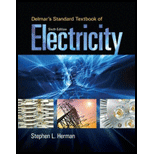
Concept explainers
Fill in all the missing values. Refer to the formulas that follow.
| Resistance | Capacitance | Time constant | Total time |
| 150
|
100
|
||
| 350
|
35 s | ||
| 350 pF | 10 s | ||
| 0.05
|
|||
| 1.2
|
0.47
|
||
|
|
0.05 s | ||
| 86
|
1.5 s | ||
| 120
|
470 pF | ||
| 250 nF | 100 ms | ||
| 8
|
150
|
||
| 100
|
150 ms | ||
| 33
|
4
|
The missing values in the table.
Answer to Problem 1PP
| Resistance | Capacitance | Time Constant | Total Time |
| 150 kΩ | 100 µF | 15 s | 75 s |
| 350 kΩ | 20 µF | 7s | 35 s |
| 142.85 MΩ | 350 pF | 0.05 s | 0.25 s |
| 40 MΩ | 0.05 µF | 2 s | 10 s |
| 1.2 MΩ | 0.47 µF | 0.564 s | 2.82 s |
| 4166.67 Ω | 12 µF | 0.05 s | 0.25 s |
| 86 kΩ | 3.488 µF | 0.3 s | 1.5 s |
| 120 kΩ | 470 pF | 56.4 µs | 282 µs |
| 80 kΩ | 250 nF | 20 ms | 100 ms |
| 3.75 Ω | 8 µF | 30 µs | 150 µs |
| 100 kΩ | 1.5 µF | 150 ms | 750 ms |
| 33 kΩ | 4 µF | 132 ms | 660 ms |
Explanation of Solution
We are given the following formulae,
Want to see more full solutions like this?
Chapter 20 Solutions
Delmar's Standard Textbook of Electricity (MindTap Course List)
- Consider the circuit diagram below. Using mesh analysis, compute the currents (a) IR1, (b) IL1, and (c) IC1. Express your final answers as phasors using polar coordinates with phase angles measured in degrees. Your solution should include the circuit diagram redrawn to indicate these currents and their directions. You must solve the system of equations using MATLAB and include the code or commands you ran as part of your solution.arrow_forwarduse kvl to solvearrow_forwardR1 is 978 ohms R2 is 2150 ohms R3 is 4780 R1 is parallel to R2 and R2 is parallel to R3 and R1 and R3 are in seriesarrow_forward
- Q7 For the circuit shown in Fig. 2.20, the transistors are identical and have the following parameters: hfe = 50, hie = 1.1K, hre = 0, and hoe = 0. Calculate Auf, Rif and Rof. Ans: 45.4; 112 KQ; 129. 25 V 10k 47k 4.7k Vo 150k w Vs 47k 4.7k W 22 5μF 33k 50uF 50μF 4.7k 4.7k R₁ Rof Rif R1000 Fig. 2.20 Circuit for Q7.arrow_forwardQ6)) The transistors in the feedback amplifier shown are identical, and their h-parameters are.. hie = 1.1k, hfe = 50, hre=o, and hoe = 0. Calculate Auf, Rif and Rof. {Ans: 6031583; 4. Kor. Is 4 4.7 k www 4.7k 91k 4.7k 91k 10k 1k. 10k 21000 4.7k w 15k Fig. 2.19 Circuit for Q6.arrow_forwardQ5 For the circuit shown in Fig. 2.18, hie =1.1 KQ, hfe =50. Find Avf, Rif and Rof Ans: -3.2; 193 ; 728 N. Vcc Vs Rs=10kQ Re=4KQ RF - = 40ΚΩ www Fig. 2.18 Circuit for Qs.arrow_forward
- Sheet No.2 Qi For the source follower shown in Fig. 2.14, Ipss =16 mA, V₂ =-4V, and VGsQ=-2.86 V. Find Avf, Rif and Rof. Assume rd is high. Ans: 0.833; ∞0; 365.7 . VDD Vo Vs R = 2.2 k Fig. 2.14 Circuit for Qi.arrow_forwardQ4 For the circuit shown in Fig. 2.17, he-100, he -1KQ. Find A, A, R and Rof- Ans:-100; -5; 100 K; 250K. Voc RB = 100 k R.=5k Vs Rs 500 R. = 1 kn Fig. 2.17 Circuit for Quarrow_forwardQ3 The circuit of Fig. 2.16 is to have Af = -1 mA/V, D=1+ BA=50, a voltage gain of -4, Rs = 1KQ, and hfe = 150. Find RL, Re, Rif and Rof. Ans: 4 KN; 980 ; 150 KN; ∞. Vcc RL Vs -OV +11 Fig. 2.16 Circuit for Q3.arrow_forward
- Q2 For the circuit shown in Fig. 2.15 hfe =150, hie =1KQ. Find Avf and Rif. Ans: 0.986; 152 KN. Vee R=4k2 Rs 1kQ Vo V, VR=1 KQ Fig. 2.15 Circuit for Q2-arrow_forwardR1 is 978 ohms, R2 is 2150 ohms R3 is 4780 ohmsarrow_forwardPleasw draw the block diagram, don't type out what it could look like. Draw it. Thank youarrow_forward
 Delmar's Standard Textbook Of ElectricityElectrical EngineeringISBN:9781337900348Author:Stephen L. HermanPublisher:Cengage Learning
Delmar's Standard Textbook Of ElectricityElectrical EngineeringISBN:9781337900348Author:Stephen L. HermanPublisher:Cengage Learning Electricity for Refrigeration, Heating, and Air C...Mechanical EngineeringISBN:9781337399128Author:Russell E. SmithPublisher:Cengage Learning
Electricity for Refrigeration, Heating, and Air C...Mechanical EngineeringISBN:9781337399128Author:Russell E. SmithPublisher:Cengage Learning

